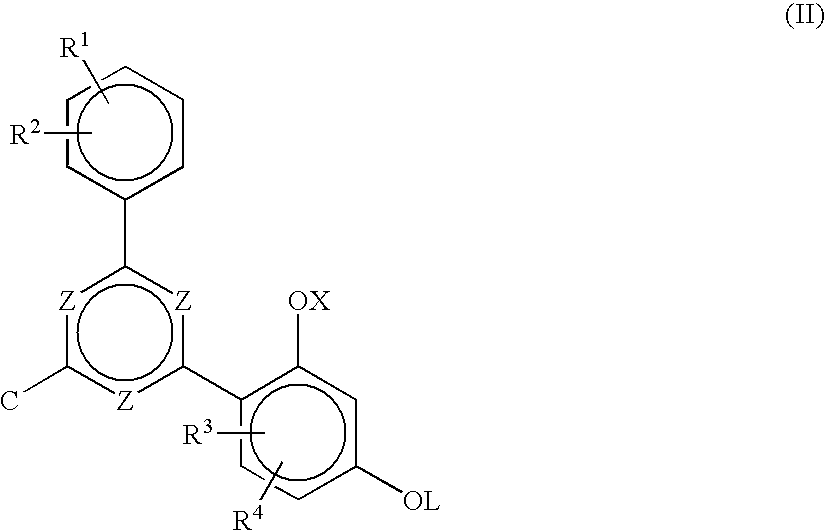Non-yellowing ortho-dialkyl aryl substituted triazine ultraviolet light absorbers
a technology of ortho-dialkyl aryl and ultraviolet light absorption, which is applied in the field of new pyrimidines and triazines ultraviolet light absorption devices, can solve the problems of polymer materials such as plastics often discoloration, brittleness, and degradation of a variety of materials
- Summary
- Abstract
- Description
- Claims
- Application Information
AI Technical Summary
Benefits of technology
Problems solved by technology
Method used
Image
Examples
example 1
Synthesis of 2-(2,4-dihydroxphenyl)-4,6-(3,4-dimethylphenyl)-1,3,5-triazine from Cyanuric Chloride in Chlorobenzene Solvent
In a 3 neck round bottom flask equipped with a mechanical stirrer, a refluxing condenser, a nitrogen inlet, and a thermocouple, was added 55.3 g cyanuric chloride and 750 ml chlorobenzene. The reaction flask was then cooled in an ice-bath to about 0° C., and then 120.0 g of AlCl3 was slowly added with stirring. After about 5 minutes, 6.0 g of concentrated hydrochloric acid was added. The reaction mixture was stirred for about 30 minutes at 0° C., further cooled to about −5° C., and 60.5 g of o-xylene was then added over a period of about 35-40 minutes. The reaction mixture was stirred at 0° C. for about 1 hour and then stirred at room temperature for 6 hours. Resorcinol (36.3 g) was then added to the reaction mixture and the resulting mixture allowed to stir for about 12 hours. The reaction mixture was then heated to about 85-90° C. for 3 hours. HPLC analysis at...
example 2
Preparation of 2-(2-hydroxy-4-octyloxyphenyl-4,6-(3,4-dimethylphenyl)-1,3,5-triazine
To a reaction flask equipped with a mechanical stirrer, a refluxing condenser, nitrogen inlet, and a thermocouple was added 90 gm of 2-(2,4-dihydroxphenyl)-4,6-(3,4-dimethylphenyl)-1,3,5-triazine (as made in Example 1), 124.4 g of potassium carbonate, 59.4 g of iodooctane, 2 g Alliquat-336, and 750 ml of methyl isobutyl ketone (MIBK). The reaction mixture was heated to reflux for 7 hrs. HPLC data showed the formation of a new product and disappearance of the 2-(2,4-dihydroxphenyl)-4,6-(3,4-dimethylphenyl)-1,3,5-triazine. The reaction mixture was cooled to room temperature, diluted with methylene chloride, filtered, and the filtrate concentrated under reduced pressure. The resulting residue was dissolved in methylene chloride, washed with water, dried, and concentrated to give 111 gm of crude product. The crude product was refluxed with acetone, and the solid filtered after cooling to room temperature...
example 3
Synthesis of 2-(2,4-dihydroxyphenyl)-4,6-(3,4-dimethylphenyl)-1,3,5-triazine from cyanuric chloride in o-dichlorobenzene solvent.
In a 3 neck, glass round bottom flask equipped with a mechanical stirrer, a refluxing condenser with nitrogen inlet and a thermocouple was added 50 g cyanuric chloride and 191 ml o-dichlorobenzene (ODCB). AlCl3 (108.4 g) was then slowly added to the flask at room temperature. After few minutes, the reaction mixture was cooled in an ice-bath, and 6.5 g of HCl was added to the reaction mixture. The reaction mixture was allowed to warm to room temperature, stirred for 2 hours, 54.7 g of o-xylene added over a 3 hour period, and the reaction mixture stirred overnight at room temperature. The reaction mixture was heated to about 63° C., and 34 g of resorcinol was added in four equal parts in 10 minute intervals. The mixture was heated at 75-80° C. for 3 hours. The reaction mixture was then cooled to room temperature and quenched with water. The o-dichlorobenzene...
PUM
| Property | Measurement | Unit |
|---|---|---|
| Fraction | aaaaa | aaaaa |
| Percent by mass | aaaaa | aaaaa |
| Thickness | aaaaa | aaaaa |
Abstract
Description
Claims
Application Information
 Login to View More
Login to View More - R&D
- Intellectual Property
- Life Sciences
- Materials
- Tech Scout
- Unparalleled Data Quality
- Higher Quality Content
- 60% Fewer Hallucinations
Browse by: Latest US Patents, China's latest patents, Technical Efficacy Thesaurus, Application Domain, Technology Topic, Popular Technical Reports.
© 2025 PatSnap. All rights reserved.Legal|Privacy policy|Modern Slavery Act Transparency Statement|Sitemap|About US| Contact US: help@patsnap.com



